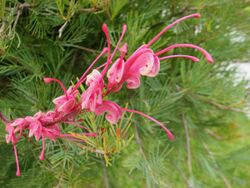Biology:Grevillea plurijuga
| Grevillea plurijuga | |
|---|---|

| |
| Grevillea plurijuga 'Purple Haze' in Royal Botanic Gardens, Cranbourne | |
| Scientific classification | |
| Kingdom: | Plantae |
| Clade: | Tracheophytes |
| Clade: | Angiosperms |
| Clade: | Eudicots |
| Order: | Proteales |
| Family: | Proteaceae |
| Genus: | Grevillea |
| Species: | G. plurijuga
|
| Binomial name | |
| Grevillea plurijuga F.Muell.[1]
| |
Grevillea plurijuga is a species of flowering plant in the family Proteaceae and is endemic to southern Western Australia. It is a prostrate to low-lying or dense mounded to erect shrub with divided leaves with linear lobes and loose clusters of hairy, red or pink flowers.
Description
Grevillea plurijuga is a prostrate to low-lying or dense mounded to erect shrub that typically grows to a height of 0.6–3 m (2 ft 0 in–9 ft 10 in) and up to 3.5 m (11 ft) wide. Its leaves are 20–130 mm (0.79–5.12 in) long and mostly divided with 8 to 24 linear lobes 20–100 mm (0.79–3.94 in) long and 0.7–1.5 mm (0.028–0.059 in) wide, the edges rolled under, enclosing the lower surface apart from the mid-vein. The flowers are arranged in loose, more or less cylindrical clusters of 8 to 40 on a hairy rachis 20–100 mm (0.79–3.94 in) long. Flowering time and colour varies with subspecies and the fruit is a glabrous, prominently ridged follicle 12–17 mm (0.47–0.67 in) long.[2][3]
Taxonomy
Grevillea plurijuga was first formally described in 1864 by Ferdinand von Mueller in Fragmenta Phytographiae Australiae from specimens collected by George Maxwell.[4][5] The specific epithet (plurijuga) means "more yokes", referring to the many leaf lobes.[6]
In 2000, Robert Owen Makinson described two subspecies of G. plurijuga in the Flora of Australia, and the names are accepted by the Australian Plant Census:
- Grevillea plurijuga F.Muell subsp. plurijuga[7] is a prostrate to low-lying, dense, mounded shrub 0.3–2 m (1 ft 0 in–6 ft 7 in) high with pale grey to pinkish-red and cream-coloured flowers from September to January. The flowers are mostly borne on long, trailing peduncles below the base of the foliage.[8][9]
- Grevillea plurijuga subsp. superba (Olde & Marriott) Makinson[10] (originally described in 1993 by as Grevillea superba in the journal Nuytsia by Peter Olde and Neil Marriott)[11][12] is a dense, robust shrub 2–4 m (6 ft 7 in–13 ft 1 in) high usually with pale grey and cream-coloured or pale yellow flowers from October to December. The flowers are mostly borne on erect peduncles held above the foliage.[13][14]
Distribution and habitat
Subspecies plurijuga grows in a range of habitats including heath, woodland and mallee between Norseman, Peak Charles, Esperance, and Cundeelee with and outlier near Southern Cross, in the Coolgardie, Esperance Plains and Mallee bioregions.[8][9] Subspecies superba grows in shrubland between Grasspatch, Scaddan, the Wittenoom Hills and Mount Ney north of Esperance in the Coolgardie, Esperance Plains and Mallee bioregions of southern Western Australia.[13][14]
Conservation status
Both subspecies of G. plurijuga are listed as "not threatened" by the Western Australian Government Department of Biodiversity, Conservation and Attractions.[8][13]
References
- ↑ "Grevillea plurijuga". Australian Plant Census. https://biodiversity.org.au/nsl/services/apc-format/display/111102.
- ↑ "Grevillea plurijuga". FloraBase. Western Australian Government Department of Parks and Wildlife. https://florabase.dpaw.wa.gov.au/browse/profile/2070.
- ↑ "Grevillea plurijuga". Australian Biological Resources Study, Department of Agriculture, Water and the Environment: Canberra. https://profiles.ala.org.au/opus/foa/profile/Grevillea%20plurijuga.
- ↑ "Grevillea plurijug". APNI. https://id.biodiversity.org.au/instance/apni/543497.
- ↑ von Mueller, Ferdinand (1864). Fragmenta Phytographiae Australiae. 4. Melbourne: Victorian Government Printer. p. 84. https://www.biodiversitylibrary.org/item/7221#page/86/mode/1up. Retrieved 25 August 2022.
- ↑ Sharr, Francis Aubi; George, Alex (2019). Western Australian Plant Names and Their Meanings (3rd ed.). Kardinya, WA: Four Gables Press. p. 280. ISBN 9780958034180.
- ↑ "Grevillea plurijugasubsp. plurijuga". Australian Plant Census. https://biodiversity.org.au/nsl/services/apc-format/display/164326.
- ↑ 8.0 8.1 8.2 "Grevillea plurijuga subsp. plurijuga". FloraBase. Western Australian Government Department of Parks and Wildlife. https://florabase.dpaw.wa.gov.au/browse/profile/19492.
- ↑ 9.0 9.1 "Grevillea plurijuga subsp. plurijuga". Australian Biological Resources Study, Department of Agriculture, Water and the Environment: Canberra. https://profiles.ala.org.au/opus/foa/profile/Grevillea%20plurijuga%20subsp.%20plurijuga.
- ↑ "Grevillea plurijuga subsp. superba". Australian Plant Census. https://biodiversity.org.au/nsl/services/apc-format/display/164327.
- ↑ "Grevillea superba". Australian Plant Census. https://biodiversity.org.au/nsl/services/apc-format/display/559323.
- ↑ Olde, Peter M.; Marriott, Neil R. (1993). "New species and taxonomic changes in Grevillea (Proteaceae: Grevilleoideae) from south-west Western Australia.". Nuytsia 9 (2): 298–302. https://www.biodiversitylibrary.org/item/224642#page/168/mode/1up. Retrieved 25 August 2022.
- ↑ 13.0 13.1 13.2 "Grevillea plurijuga subsp. superba". FloraBase. Western Australian Government Department of Parks and Wildlife. https://florabase.dpaw.wa.gov.au/browse/profile/19491.
- ↑ 14.0 14.1 "Grevillea plurijuga subsp. superba". Australian Biological Resources Study, Department of Agriculture, Water and the Environment: Canberra. https://profiles.ala.org.au/opus/foa/profile/Grevillea%20plurijuga%20subsp.%20superba.
Wikidata ☰ {{{from}}} entry
 |

